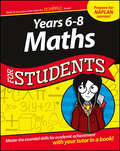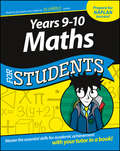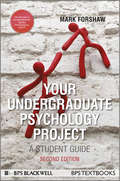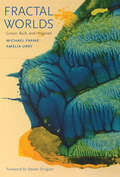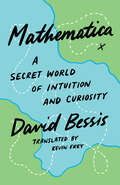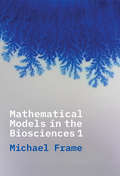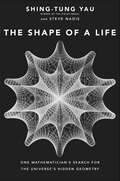- Table View
- List View
Years 6 - 8 Maths For Students
by Consumer DummiesYour tutor in a book! Master the essential mathematical skills for success! 'I don't know how to do this' is a refrain heard whilst many a student is doing homework. Parents are increasingly called on for assistance, but are themselves struggling to help their children. Years 6-8 Maths For Students is a reference guide for both students and parents, aiming to fill the gaps in a student's knowledge base, build confidence and reduce stress. Written with the same friendly, how-to approach of the successful For Dummies books, this new educational reference will empower students and develop their mathematical skills for exams, NAPLAN testing and, most importantly, life beyond secondary school. With worries that students are being taught to pass tests at the expense of understanding — this guide will help students cement their mathematical foundations. Grasp the nuts and bolts of numbers, algebra, geometry and measurement Helps students with maths as they transition from primary to secondary school Complete homework and prepare for tests with confidence Save money on expensive tutors. Years 6-8 Maths For Students empowers students to improve their educational outcomes.
Years 6 - 8 Maths For Students
by Consumer DummiesYour tutor in a book! Master the essential mathematical skills for success! 'I don't know how to do this' is a refrain heard whilst many a student is doing homework. Parents are increasingly called on for assistance, but are themselves struggling to help their children. Years 6-8 Maths For Students is a reference guide for both students and parents, aiming to fill the gaps in a student's knowledge base, build confidence and reduce stress. Written with the same friendly, how-to approach of the successful For Dummies books, this new educational reference will empower students and develop their mathematical skills for exams, NAPLAN testing and, most importantly, life beyond secondary school. With worries that students are being taught to pass tests at the expense of understanding — this guide will help students cement their mathematical foundations. Grasp the nuts and bolts of numbers, algebra, geometry and measurement Helps students with maths as they transition from primary to secondary school Complete homework and prepare for tests with confidence Save money on expensive tutors. Years 6-8 Maths For Students empowers students to improve their educational outcomes.
Years 9 - 10 Maths For Students
by Consumer DummiesYour tutor in a book! Master the essential mathematical skills for success! 'I don't know how to do this' is a refrain heard whilst many a student is doing homework. Parents are increasingly called on for assistance, but are themselves struggling to help their children. Years 9-10 Maths For Students is a reference guide for both students and parents, aiming to fill the gaps in a student's knowledge base, build confidence and reduce stress. Written with the same friendly, how-to approach of the successful For Dummies books, this new educational reference will empower students and develop their mathematical skills for exams, NAPLAN testing and, most importantly, life beyond secondary school. With worries that students are being taught to pass tests at the expense of understanding — this guide will help students cement their mathematical foundations. Grasp the nuts and bolts of numbers, algebra, geometry and measurement. Master simple to complex maths questions, including worded problems Complete homework and prepare for tests with confidence Save money on expensive tutors. Years 9-10 Maths For Students empowers students to improve their educational outcomes.
Years 9 - 10 Maths For Students
by Consumer DummiesYour tutor in a book! Master the essential mathematical skills for success! 'I don't know how to do this' is a refrain heard whilst many a student is doing homework. Parents are increasingly called on for assistance, but are themselves struggling to help their children. Years 9-10 Maths For Students is a reference guide for both students and parents, aiming to fill the gaps in a student's knowledge base, build confidence and reduce stress. Written with the same friendly, how-to approach of the successful For Dummies books, this new educational reference will empower students and develop their mathematical skills for exams, NAPLAN testing and, most importantly, life beyond secondary school. With worries that students are being taught to pass tests at the expense of understanding — this guide will help students cement their mathematical foundations. Grasp the nuts and bolts of numbers, algebra, geometry and measurement. Master simple to complex maths questions, including worded problems Complete homework and prepare for tests with confidence Save money on expensive tutors. Years 9-10 Maths For Students empowers students to improve their educational outcomes.
Your Undergraduate Psychology Project: A Student Guide
by Mark ForshawYour Undergraduate Psychology Project: A Student Guide has been designed with the needs of the student in mind. Packed with hints and tips, and written in a simple, informal style, this ‘second supervisor’ is designed to ease students further into the world of research. The second edition has been completely revised and updated with new material on focus groups and ethics and a new section entitled How to Lose Marks Instantly Structured chronologically around planning a project, carrying it out, and then writing it up. Gives practical advice on how to deal with day-to-day problems such as software failures or uncommunicative interviewees. Written in consultation with a number of experienced academics and students of psychology.
The American Census: A Social History, Second Edition
by Margo J. AndersonThis book is the first social history of the census from its origins to the present and has become the standard history of the population census in the United States. The second edition has been updated to trace census developments since 1980, including the undercount controversies, the arrival of the American Community Survey, and innovations of the digital age. Margo J. Anderson’s scholarly text effectively bridges the fields of history and public policy, demonstrating how the census both reflects the country’s extraordinary demographic character and constitutes an influential tool for policy making. Her book is essential reading for all those who use census data, historical or current, in their studies or work.
Beautiful, Simple, Exact, Crazy: Mathematics in the Real World
by Apoorva Khare Anna LachowskaIn this vibrant work, which is ideal for both teaching and learning, Apoorva Khare and Anna Lachowska explain the mathematics essential for understanding and appreciating our quantitative world. They show with examples that mathematics is a key tool in the creation and appreciation of art, music, and literature, not just science and technology. The book covers basic mathematical topics from logarithms to statistics, but the authors eschew mundane finance and probability problems. Instead, they explain how modular arithmetic helps keep our online transactions safe, how logarithms justify the twelve-tone scale commonly used in music, and how transmissions by deep space probes are similar to knights serving as messengers for their traveling prince. Ideal for coursework in introductory mathematics and requiring no knowledge of calculus, Khare and Lachowska’s enlightening mathematics tour will appeal to a wide audience.
Causal Inference: The Mixtape
by Scott CunninghamAn accessible and contemporary introduction to the methods for determining cause and effect in the social sciences Causal inference encompasses the tools that allow social scientists to determine what causes what. Economists—who generally can’t run controlled experiments to test and validate their hypotheses—apply these tools to observational data to make connections. In a messy world, causal inference is what helps establish the causes and effects of the actions being studied, whether the impact (or lack thereof) of increases in the minimum wage on employment, the effects of early childhood education on incarceration later in life, or the introduction of malaria nets in developing regions on economic growth. Scott Cunningham introduces students and practitioners to the methods necessary to arrive at meaningful answers to the questions of causation, using a range of modeling techniques and coding instructions for both the R and Stata programming languages.
Field Experiments and Their Critics: Essays on the Uses and Abuses of Experimentation in the Social Sciences (The Institution for Social and Policy Studies)
by Dawn Langan TeeleIn recent years, social scientists have engaged in a deep debate over the methods appropriate to their research. Their long reliance on passive observational collection of information has been challenged by proponents of experimental methods designed to precisely infer causal effects through active intervention in the social world. Some scholars claim that field experiments represent a new gold standard and the best way forward, while others insist that these methods carry inherent inconsistencies, limitations, or ethical dilemmas that observational approaches do not. This unique collection of essays by the most influential figures on every side of this debate reveals its most important stakes and will provide useful guidance to students and scholars in many disciplines.
Fractal Worlds: Grown, Built, and Imagined
by Michael Frame Amelia UrryFractal geometry is a uniquely fascinating area of mathematics, exhibited in a range of shapes that exist in the natural world, from a simple broccoli floret to a majestic mountain range. In this essential primer, mathematician Michael Frame—a close collaborator with Benoit Mandelbrot, the founder of fractal geometry—and poet Amelia Urry explore the amazing world of fractals as they appear in nature, art, medicine, and technology. Frame and Urry offer new insights into such familiar topics as measuring fractal complexity by dimension and the life and work of Mandelbrot. In addition, they delve into less-known areas: fractals with memory, the Mandelbrot set in four dimensions, fractals in literature, and more. An inviting introduction to an enthralling subject, this comprehensive volume is ideal for learning and teaching.
The Logic of Miracles: Making Sense of Rare, Really Rare, and Impossibly Rare Events
by Laszlo MeroWe live in a much more turbulent world than we like to think, but the science we use to analyze economic, financial, and statistical events mostly disregards the world’s essentially chaotic nature. We need to get used to the idea that wildly improbable events are actually part of the natural order. The renowned Hungarian mathematician and psychologist László MérŠ‘ explains how the wild and mild worlds (which he names Wildovia and Mildovia) coexist, and that different laws apply to each. Even if we live in an ultimately wild universe, he argues, we’re better off pretending that it obeys Mildovian laws. Doing so may amount to a self†‘fulfilling prophecy and create an island of predictability in a very rough sea. Perched on the ragged border between economics and complexity theory, MérŠ‘ proposes to extend the reach of science to subjects previously considered outside its grasp: the unpredictable, unrepeatable, highly improbable events we commonly call “miracles.”
Mathematica: A Secret World of Intuition and Curiosity
by David BessisA fascinating look into how the transformative joys of mathematical experience are available to everyone, not just specialists Math has a reputation for being inaccessible. People think that it requires a special gift or that comprehension is a matter of genes. Yet the greatest mathematicians throughout history, from René Descartes to Alexander Grothendieck, have insisted that this is not the case. Like Albert Einstein, who famously claimed to have “no special talent,” they said that they had accomplished what they did using ordinary human doubts, weaknesses, curiosity, and imagination. David Bessis guides us on an illuminating path toward deeper mathematical comprehension, reconnecting us with the mental plasticity we experienced as children. With simple, concrete examples, Bessis shows how mathematical comprehension is integral to the great learning milestones of life, such as learning to see, to speak, to walk, and to eat with a spoon. Focusing on the deeply human roots of mathematics, Bessis dispels the myths of mathematical genius. He offers an engaging initiation into the experience of math not as a series of discouragingly incomprehensible logic problems but as a physical activity akin to yoga, meditation, or a martial art. This perspective will change the way you think not only about math but also about intelligence, intuition, and everything that goes on inside your head.
Mathematical Models in the Biosciences I
by Michael FrameAn award-winning professor’s introduction to essential concepts of calculus and mathematical modeling for students in the biosciences This is the first of a two-part series exploring essential concepts of calculus in the context of biological systems. Michael Frame covers essential ideas and theories of basic calculus and probability while providing examples of how they apply to subjects like chemotherapy and tumor growth, chemical diffusion, allometric scaling, predator-prey relations, and nerve impulses. Based on the author’s calculus class at Yale University, the book makes concepts of calculus more relatable for science majors and premedical students.
Mathematical Models in the Biosciences II
by Michael FrameVolume Two of an award-winning professor’s introduction to essential concepts of calculus and mathematical modeling for students in the biosciences This is the second of a two-part series exploring essential concepts of calculus in the context of biological systems. Building on the essential ideas and theories of basic calculus taught in Mathematical Models in the Biosciences I, this book focuses on epidemiological models, mathematical foundations of virus and antiviral dynamics, ion channel models and cardiac arrhythmias, vector calculus and applications, and evolutionary models of disease. It also develops differential equations and stochastic models of many biomedical processes, as well as virus dynamics, the Clancy-Rudy model to determine the genetic basis of cardiac arrhythmias, and a sketch of some systems biology. Based on the author’s calculus class at Yale, the book makes concepts of calculus less abstract and more relatable for science majors and premedical students.
Mathematics for Human Flourishing
by Francis SuAn inclusive vision of mathematics—its beauty, its humanity, and its power to build virtues that help us all flourish For mathematician Francis Su, a society without mathematical affection is like a city without concerts, parks, or museums. To miss out on mathematics is to live without experiencing some of humanity’s most beautiful ideas. In this profound book, written for a wide audience but especially for those disenchanted by their past experiences, an award†‘winning mathematician and educator weaves parables, puzzles, and personal reflections to show how mathematics meets basic human desires—such as for play, beauty, freedom, justice, and love—and cultivates virtues essential for human flourishing. These desires and virtues, and the stories told here, reveal how mathematics is intimately tied to being human. Some lessons emerge from those who have struggled, including philosopher Simone Weil, whose own mathematical contributions were overshadowed by her brother’s, and Christopher Jackson, who discovered mathematics as an inmate in a federal prison. Christopher’s letters to the author appear throughout the book and show how this intellectual pursuit can—and must—be open to all.
The Shape of a Life: One Mathematician's Search for the Universe's Hidden Geometry
by Shing-Tung Yau Steve NadisA Fields medalist recounts his lifelong transnational effort to uncover the geometric shape—the Calabi-Yau manifold—that may store the hidden dimensions of our universe. Harvard geometer and Fields medalist Shing-Tung Yau has provided a mathematical foundation for string theory, offered new insights into black holes, and mathematically demonstrated the stability of our universe. In this autobiography, Yau reflects on his improbable journey to becoming one of the world’s most distinguished mathematicians. Beginning with an impoverished childhood in China and Hong Kong, Yau takes readers through his doctoral studies at Berkeley during the height of the Vietnam War protests, his Fields Medal–winning proof of the Calabi conjecture, his return to China, and his pioneering work in geometric analysis. This new branch of geometry, which Yau built up with his friends and colleagues, has paved the way for solutions to several important and previously intransigent problems. With complicated ideas explained for a broad audience, this book offers readers not only insights into the life of an eminent mathematician, but also an accessible way to understand advanced and highly abstract concepts in mathematics and theoretical physics.
Truth or Beauty: Science and the Quest for Order
by David OrrellIn this sweeping book, applied mathematician and popular author David Orrell questions the promises and pitfalls of associating beauty with truth, showing how ideas of mathematical elegance have inspired—and have sometimes misled—scientists attempting to understand nature. Orrell shows how the ancient Greeks constructed a concept of the world based on musical harmony; later thinkers replaced this model with a program, based on Newton’s “rational mechanics,” to reduce the universe to a few simple equations. He then turns to current physical theories, such as supersymmetric string theory—again influenced by deep aesthetic principles. The book sheds new light on historical investigations and also recent research, including the examinations ongoing at the Large Hadron Collider. Finally, broadening his discussion to other fields of research, including economics, architecture, and health, Orrell questions whether these aesthetic principles reflect an accurate way to explain and understand the structure of our world.
What Is a Complex System?
by James Ladyman Karoline WiesnerA clear, concise introduction to the quickly growing field of complexity science that explains its conceptual and mathematical foundations What is a complex system? Although “complexity science” is used to understand phenomena as diverse as the behavior of honeybees, the economic markets, the human brain, and the climate, there is no agreement about its foundations. In this introduction for students, academics, and general readers, philosopher of science James Ladyman and physicist Karoline Wiesner develop an account of complexity that brings the different concepts and mathematical measures applied to complex systems into a single framework. They introduce the different features of complex systems, discuss different conceptions of complexity, and develop their own account. They explain why complexity science is so important in today’s world.
الأخلاق والسير في مداواة النفوس
by أبي محمد علي بن حزم الأندلسي الظاهريقد جمعت في كتابي هذا معان كثيرة أفادنيها واهب التمييز تعالى بمرور الأيام وتعاقب الأحوال بما منحني عز وجل من التهمم بتصاريف الزمان والإشراف على أحواله حتى أنفقت في ذلك أكثر عمري وآثرت تقييد ذلك بالمطالعة له والفكرة فيه على جميع اللذات التي تميل إليها أكثر النفوس وعلى الازدياد من فضول المال ورقمت كل ما سبرت من ذلك بهذا الكتاب لينفع الله تعالى به من شاء من عباده ممن يصل إليه ما أتعبت فيه نفسي واجهدتها فيه واطلت فيه فكري فيأخذه عفوا وأهديته إليه هنيئا فيكون ذلك أفضل له من كنوز المال وعقد الأملاك إذا تدبره ويسره الله تعلي لاستعماله. وانا راج في ذلك من الله تعالي أعظم الأجر لنيتي في نفع عباده وإصلاح ما فسد من أخلاقهم ومداواة علل نفوسهم وبالله تعالى استعين وحسبنا الله ونعم الوكيل
الرسالة المستطرقة فى علوم الحديث
by محمد بن جعفر الكتانيوقد قال (ابن حجر) في أول (مقدمة فتح الباري) ما نصه: اعلم أن آثار النبي ـ صلى الله عليه وسلم ـ لم تكن في عصر الصحابة وكبار التابعين مدونة في الجوامع، ولا مرتبه، لأمرين: أحدهما: أنهم كانوا في ابتداء الحال قد نهوا عن ذلك، كما ثبت في (صحيح مسلم)، خشية أن يختلط بعض ذلك بالقرآن العظيم. وثانيهما: لسعة حفظهم، وسيلان أذهانهم، ولأن أكثرهم كانوا لا يعرفون الكتابة. ثم حدث في أواخر عصر التابعين تدوين الآثار، وتبويب الأخبار، لمّا انتشر العلماء في الأمصار، وكثر الابتداع من الخوارج والروافض ومنكري الأقدار، واتسع الخرق على الراقع، وكاد أن يلتبس الباطل بالحق. فأول من جمع في ذلك (الربيع بن صبيح) (وسعيد ابن أبي عروبة) وغيرهما. دونت أحكام الحديث في منتصف القرن الثاني وكانوا يصنفون كل باب على حده، إلى أن قام كبار أهل الطبقة الثانية في منتصف القرن (ص 6) الثاني، فدونوا الأحكام. فصنف (الإمام مالك) (الموطأ) بالمدينة، وتوخى فيه القوي من حديث أهل الحجاز، ومزجه بأقوال الصحابة، وفتاوى التابعين، ومن بعدهم. أول من صنف الحديث بمكة ابن جريج وصنف (أبو محمد عبد الملك بن عبد العزيز بن جريج) بمكة، (وأبو عمرو عبد الرحمن بن عمرو الأوزاعي) بالشام، (وأبو عبد الله سفيان بن سعيد الثوري) بالكوفة، (وأبو سلمة حماد بن سلمة بن دينار) بالبصرة. ثم تلاهم كثير من أهل عصرهم في النسج على منوالهم، إلى أن رأى بعض الأئمة منهم، أن يفرد حديث النبي ـ صلى الله عليه وسلم ـ خاصة، وذلك على رأس المائتين. فصنف (عبيد الله بن موسى العبسي الكوفي) مسندا، وصنف (مسدد بن مسرهد البصري) مسندا، وصنف (أسد بن موسى الأموي) مسندا، وصنف (نُعيم بن حماد الخزاعي) نزيل مصر مسندا، ثم اقتفى الأئمة بعد ذلك أثرهم، فقلَّ إمام من الحفاظ إلا وصنف حديثه على المسانيد، (كالإمام أحمد بن حنبل) (و إسحاق بن راهويه) (وعثمان بن أبي شيبة) وغيرهم من النبلاء. ومنهم من صنف على الأبواب والمسانيد معا (كأبي بكر بن أبي شيبة) اهـ. وعبارته في (إرشاد الساري) قال: منهم من رتب على المسانيد (كالإمام أحمد بن حنبل) (و إسحاق بن راهويه) (وأبي بكر ابن أبي شيبة) (وأحمد بن منيع) (وأبي خيثمة) (والحسن بن سفيان) (وأبي بكر البزار) وغيرهم. ومنهم من رتب على العلل: بأن يجمع في كل متن طرقه، واختلاف الرواة فيه، بحيث يتضح إرسال ما يكون متصلا، أو وقف ما يكون مرفوعا، أو غير ذلك. ومنهم من رتب على الأبواب الفقهية، وغيرها، ونوّعه أنواعا، وجمع ما ورد في كل نوع، وفي كل حكم إثباتا ونفيا، في باب فباب، بحيث يتميز ما يدخل في الصوم مثلا عما يتعلق بالصلاة. وأهل هذه الطريقة منهم من تقيد بالصحيح (كالشيخين) وغيرهما، ومنهم من لم يتقيد بذلك كباقي الكتب الستة، وكان أول من صنف في الصحيح (محمد بن إسماعيل البخاري). ومنهم المقتصر على (ص 7) الأحاديث المتضمنة للترغيب والترهيب، ومنهم من حذف الإسناد واقتصر على المتن فقط، (كالبغوي) في (مصابيحه) (واللؤلؤي) في (مشكاته) اهـ.
الفصل في الملل و الآهواء و النحل
by ابن حزمإن كثيراً من الناس كتبوا في افتراق الناس في دياناتهم ومقالاتهم كتباً كثيرة جداً فبعض أطال وأسهب وأكثر وهجر واستعمل الأغاليط والشغب فكان ذلك شاغلاً عن الفهم قاطعاً دون العلم وبعض حذف وقصر وقلل واختصر واضرب عن كثير من قوي معارضات أصحاب المقالات فكان في ذلك غير منصف لنفسه في أن يرضى لها بالغبن في الإبانة وظالماً لخصمه في أن لم يوفه حق اعتراضه وباخساً حق من قرأ كتابه إذ لم يغنه عن غيره وكلهم إلا تحلة القسم عقد كلامه تعقيداً يتعذر فهمه على كثير من أهل الفهم وحلق على المعاني من بعد حتى صار ينسي آخر كلامه أوله وأكثر هذا منهم ستائر دون فساد معانيهم فكان هذا منهم غير محمود في عاجله وآجله.
CK-12 Probability and Statistics (Basic)
by Ck-12 FoundationAn open source textbook on probability and statistics.
Intermediate Algebra
by OpenStax"Intermediate Algebra is designed to meet the scope and sequence requirements of a one-semester Intermediate algebra course. The book's organization makes it easy to adapt to a variety of course syllabi. The text expands on the fundamental concepts of algebra while addressing the needs of students with diverse backgrounds and learning styles. Each topic builds upon previously developed material to demonstrate the cohesiveness and structure of mathematics."--Open Textbook Library.
Introduction to Economic Analysis
by R. Preston McafeeThis book presents introductory economics ("principles") material using standard mathematical tools, including calculus. It is designed for a relatively sophisticated undergraduate who has not taken a basic university course in economics. It also contains the standard intermediate microeconomics material and some material that ought to be standard but is not. The book can easily serve as an intermediate microeconomics text. The focus of this book is on the conceptual tools and not on fluff. Most microeconomics texts are mostly fluff and the fluff market is exceedingly over-served by $100+ texts. In contrast, this book reflects the approach actually adopted by the majority of economists for understanding economic activity. There are lots of models and equations and no pictures of economists.
Introduction to Probability
by Charles M. Grinstead Laurie J. SnellAn open source textbook on probability.
